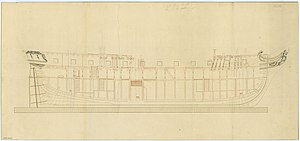 Plan of an Enterprise-class frigate, similar to Aurora
| |
| History | |
|---|---|
| Name | HMS Aurora |
| Ordered | 3 July 1776 |
| Builder | John Perry & Co, Blackwall |
| Laid down | July 1776 |
| Launched | 7 June 1777 |
| Completed | 9 August 1777 (at Woolwich Dockyard) |
| Commissioned | July 1777 |
| Fate | Sold to break up 3 November 1814 |
| General characteristics | |
| Class and type | 28-gun Enterprise-class sixth-rate frigate |
| Tons burthen | 595 86⁄94 (bm) |
| Length |
|
| Beam | 33 ft 7 in (10.2 m) |
| Depth of hold | 11 ft 0 in (3.35 m) |
| Sail plan | Full-rigged ship |
| Complement | 200 officers and men |
| Armament |
|
HMS Aurora was a 28-gun Enterprise-class sixth-rate frigate of the Royal Navy, that saw service during the American and French Revolutionary wars, and the Napoleonic Wars. Designed to carry a complement of 200 men, she was armed with a main battery of twenty-four 9-pound guns.
Launched in June 1777, she was commissioned the following month and sent to the West Indies where she formed part of a squadron under Vice-admiral Clark Gayton, attacking American shipping interests in the area. On 13 January 1778, under command of Capt. Harmon Courter, she captured the American privateer "St. Peter".[1] Her tender, schooner Libra, captured sloop Fly on 21 February, 1778.[2]
At the beginning of 1794 Aurora was among the British vessels assisting Sir David Dundas in capturing the town of San Fiorenzo, Corsica. In January 1797, Aurora came under the command of Henry Digby in the Mediterranean and in November the following year, took part in the capture of Minorca.
Returning to the West Indies in 1808, she joined Charles Dashwood's squadron which took possession of the town of Samaná in November and in July 1809, escorted a large force under Hugh Lyle Carmichael sent to expel the French from the city of Santo Domingo. In December 1810, Aurora was laid up, then on 3 November 1814, she was sold.
- ^ "NAVAL DOCUMENTS OF The American Revolution" (PDF). history.navy.mil. Retrieved 22 November 2021.
- ^ "Naval Documents of The American Revolution Volume 11 European THEATRE: Jan. 1, 1778–Mar. 31, 1778 American: Jan. 1, 1778–Mar. 31, 1778" (PDF). U.S. Government printing office via Imbiblio. Retrieved 7 December 2023.
